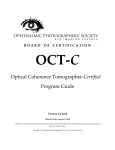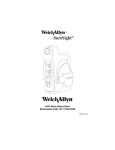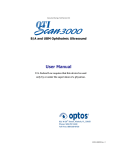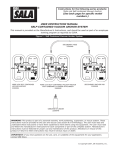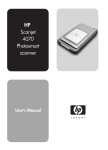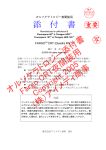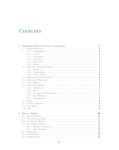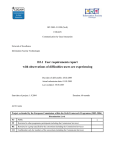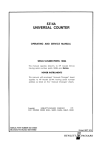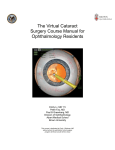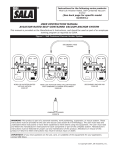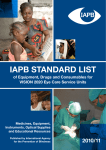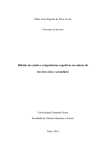Download ICLTM / TORIC ICLTM
Transcript
ICL / TORIC ICL TM TM STAAR Surgical AG Hauptstrasse 104 P.O. Box 463 CH-2560 Nidau Switzerland Tel +41 32 332 88 88 Fax +41 32 332 88 99 [email protected] www.staar.com www.iclinfo.info Introduction Welcome to a new era in refractive surgery. The ICL and Toric ICL are posterior chamber, TM TM sulcus located phakic intraocular lenses for the treatment of myopia, hyperopia and astigmatism. This manual will help guide you through the patient selection process, surgical procedure and follow-up care for your patients receiving the ICL and Toric ICL . TM TM Welcome to the world of High Definition Vision. Table of ContentS Chapter 1 - ICLTM / Toric ICLTM Certification Process ICL / Toric ICL TM TM Certification Process 10 Clear Corneal Temporal Incision 29 ICL / Toric ICL 30 TM TM Injection Positioning the ICL 31 TM Chapter 2 - Product Information Aligning the Toric ICL 31 Indications for Use 12 Removal of Viscoelastic 32 Contraindications 12 Constricting the Pupil 32 Endothelial Cell Density 12 Post-operative Medication 32 Lens Material 13 Optical Diameter 14 TM Chapter 3 - Pre-operative Preparation Pre-operative Examination 16 Measuring White-to-White 16 Peripheral Iridotomy / Iridectomy (PI) 16 ICLTM / Toric ICLTM Power Calculation 18 Lens Ordering 18 Chapter 4 - Marking the Cornea for Toric ICL™ Chapter 7 - Post-operative Assessment and Complication Management Early Post-operative Examination (2-4 hours) 34 Evaluating the Vault 34 Routine Post-operative Examination 34 Considerations 35 Power / Size 35 Wound Construction 35 Improper Loading 35 Poor Insertion 36 Early Post-operative Complications 36 Marking the Cornea 20 IOP Spike / Elevated IOP 36 Pupil Dilation 20 Inadequate Vault 36 Excessive Vault 37 Traumatic Cataract 37 Implantation and Pupil Dilation Chapter 5 - ICL™ / Toric ICL™ Loading Technique Required Instruments for Loading and Implantation 22 ICL / Toric ICL 22 Cataract 23 Decentered ICL TM TM Handling Precautions Step-by-Step Lens Loading Late Post-operative Complications 37 38 38 TM Atypical Late Post-operative Findings Chapter 6 - Surgical Procedure 38 Pigment on the ICL 38 TM Patient Preparation 28 Iris Transillumination Anesthesia 28 Technique for ICL / Toric ICL Surgical Technique 28 Decision Tree 28 Comparative Studies of ICL Marking the Cornea for Toric ICL TM Implantation Paracentesis 29 Injection of Viscoelastic 29 38 TM TM Removal 39 41 TM and Toric ICL TM 42 ICL / TORIC ICL User’s manual TM TM ICLTM / Toric ICLTM Certification Process ICL / TORIC ICL Certification Process TM TM ICL / TORIC ICL User’s manual TM ICLTM / Toric ICLTM certification is a mandatory requirement for physicians who are interested in implanting the lens. Physician certification for implantation of the ICLTM is part of STAAR Surgical’s ongoing commitment to excellence in ophthalmology. A physician becomes eligible for certification after attending an official ICLTM / Toric ICLTM Certification Course. Once eligible, the physician will complete certification by successfully selecting, implanting and managing his/her first surgical procedures with the support of an on-site STAAR Surgical ICLTM / Toric ICLTM Product Specialist. International certification courses are part of a two-step certification program. The first step in the process is a one-day course consisting of a four-hour didactic presentation, lens loading lab, live surgery observation and examination of postoperative patients. The second part of this program consists of successful completion of the first surgeries under the guidance of a Product Specialist. The Toric ICL TM The Product Specialist will contact the physician to arrange the logistics of the certification. Several important factors shall be discussed during this initial contact including: • Scheduling appropriate surgical and clinical staff trainings • Scheduling pre-surgical time to review the surgical steps and lens-loading procedure • Reviewing a pre-surgical checklist of the required instrumentation • Reviewing potential ICLTM / Toric ICLTM candidates for accurate patient selection The ICLTM / Toric ICLTM is a posterior chamber phakic IOL located in the sulcus Please keep in mind when requesting a proctoring date that the certification usually takes up to three days: • Day one – train staff and review all necessary surgical steps • Day two – perform surgery • Day three – one-day postoperative patient review and answering any remaining questions Additionally, peripheral YAG Iridotomies must be performed one to two weeks prior to surgery. Also remember that careful selection of patients is critical to successful certification. 10 Product Information Indications for Use Contraindications Endothelial Cell Density Lens Material Optical Diameter TM Product information ICMTM -3.0 D to -23.0 D ICH™ +3.0 D to +21.0 D Toric ICLTM -3.0 D to -23.0 D (sphere), +1.0 D to +6.0 D (cylinder) - With anterior chamber depth (ACD) of 2.8 mm or greater and a stable refractive history within 0.5 D for one year prior to implantation - Intended for placement in the posterior chamber of the phakic eye Corneal Endothelium ACD Anterior Crystalline Lens 12 Contraindications The ICLTM is not recommended in patients: • Patients with unstable refraction in the past 12 months (myopia and / or astigmatism) • Patients who do not fall in the range of pre-op myopia, hyperopia or astigmatism as outlined in the indications for use • Patients under 21 or over 45 years of age • Patients with an ACD of less than 2.8 mm as measured from the corneal endothelium • Patients with low endothelial cell count, Fuchs’ dystrophy or other corneal pathology • Patients with a history of iritis, uveitis, synechiae, pigment dispersion syndrome, retinal disease (other than manifestation of myopic degeneration), chronic intraocular inflammation, macular degeneration, irregular astigmatism, keratoconus or cystoid macular edema in either eye. • Patients with diabetic retinopathy in either eye • Patients with glaucoma or diagnosis of ocular hypertension in either eye • Patients with history of previous intraocular surgery (including refractive surgery) in the eye to be treated • Patients who are amblyopic or blind in the fellow eye • Patients with a progressive sight-threatening disease. Patients with retinal findings associated with pathological myopia are allowed. • Patients with cataract in either eye or systemic collagen sensitivity • Patients with insulin-dependent diabetes • Patients who are pregnant or nursing Endothelial Cell Density The following table indicates the minimum ECD per age group at time of implantation for three different ACD ranges and is to be used as a reference. This table was developed using rates of 2.47 %, 2.44%, and 2.15 % (the upper 90 % confidence interval of the average cell loss for eyes with the specified ACD) for the ≥3.0 mm, ≥3.2 mm, and ≥3.5 mm groups, respectively. It sets minimum ECD criteria as functions of age that should result in at least 1000 cells/mm 2 at 75 years of age. The patient’s ECD should be monitored periodically; methodology for determining cell density is at the discretion of the physician. Age (years) Minimum ECD Minimum ECD Minimum ECD ACD ≥ 3.0 mm ACD ≥ 3.2 mm ACD ≥ 3.5 mm 21 - 25 3875 cells/mm2 3800 cells/mm2 3250 cells/mm2 26 - 30 3425 cells/mm2 3375 cells/mm2 2900 cells/mm2 31 - 35 3025 cells/mm2 2975 cells/mm2 2625 cells/mm2 36 - 40 2675 cells/mm2 2625 cells/mm2 2350 cells/mm2 41 - 45 2350 cells/mm2 2325 cells/mm2 2100 cells/mm2 > 45 2075 cells/mm2 2050 cells/mm2 1900 cells/mm2 Lens Material The ICLTM is lathe manufactured from a proComparision of RMS values of different IOLs with a consistent pupil of 4.5 mm (Tracy VFA) prietary collagen copolymer material known Pre-operative 1 Week Post-operative ® as Collamer . The material has a refractive 1.4 1.28 1.2 index of 1.453 at 35ºC, a specific gravity of 1.0 1.13 1.21 and durometer hardness (shore A) of 0.93 0.8 45. The polymer material absorbs ultraviolet 0.6 0.6 radiation, with light transmittance in the 0.4 visible region of the spectrum of approxi0.33 0.33 0.31 0.2 0.29 mately 90 % ±5 % with over 90 % of 0 STAAR AMO Alcon STAAR ultraviolet radiation blocked below 387 nm Silicone Sensar SA 60 Collamer ® wavelength. Collamer has several unique advantages. Since the collagen contained in the lens is negatively charged, it repels like charge particles such as proteins and cells. As such, the lens exhibits virtually no postoperative protein deposition. RMS Value Indications for Use The ICLTM (myopic, hyperopic and toric version) is indicated: - For use in adults 21 to 45 years of age - Available diopter range (0.5 D increments): ® ® ® 13 ICL / TORIC ICL User’s manual TM In vitro testing for protein adherence to acrylic and Collamer® materals. Acrylic lenses: Cellular (protein) adherence. TM Collamer ® also exhibits an inherent anti-reflective coating property.The gradual change in refractive index at the surface of the lens results in a significant reduction in glare 1 . These properties combine to provide a lens material that induces fewer postoperative higher order aberrations than other lens materials 2 . The ICLTM provides exceptional quality of vision and biocompatibility for excellent long-term stability within the eye. Collamer® lenses: Free of cellular or protein deposits. Collamer® (lens on the top) reduces lens surface glare compared to acrylic. Optical Diameter The optical diameter varies with the spherical power of the ICLTM . The table below illustrates the relationship between optical diameter and power. Due to the magnification of the cornea, the effective corneal optical zone is greater than the actual optical diameter of the ICLTM . Pre-operative Preparation Pre-operative Examination Measuring White-to-White Power (D) Optical Diameter (mm) Effective Optical Diameter at Corneal Plane (mm)* -3.0 to -12.0 5.50 7.30 -12.5 to -13.5 5.25 6.93 ICLTM / Toric ICLTM Power Calculation -14.0 to -16.5 5.00 6.62 Lens Ordering -17.0 to -23.0 4.65 6.17 *Once implanted in the eye 1) Ossipov A. Comparison of internal reflectance patterns of Collamer ® , acrylic and silicone. 1997. 2) Martin RG, Sanders DR. Higher order aberrations following implantation of four foldable lens designs, Presented at: ASCRS 2003. Peripheral Iridotomy / Iridectomy (PI) Pre-operative Preparation Corneal Endothelium ACD Anterior Crystalline Lens Pre-operative Examination A typical comprehensive pre-operative eye examination should include the following: • Thorough ocular history • Careful and precise manifest and cycloplegic refraction • Visual acuity with and without correction • Keratometry or corneal topography • Corneal pachymetry • Careful measurement of the ACD (as measured from the corneal endothelium to anterior surface of the crystalline lens) • Pupil size in normal and scotopic conditions • Endothelial cell count • Intraocular pressure • Comprehensive dilated slit-lamp exam to include the retina • Careful measurement of the horizontal white-to-white distance • Goniscopy • Assessment of the crystalline lens • Axial length (Biometry) Measuring White-to-White There are various methods for measuring horizontal white-towhite distance. Accurate measurement of white-to-white is critical for proper sizing of the ICLTM . To determine the ICLTM length, a nomogram using white-to-white and ACD is utilized. Physical measurement with calibrated calipers is one of the most reliable methods for obtaining the measurement. The patient should be reclined in the examination chair, the cornea anesthetized, and the measurement taken using magnification, such as surgical loupes or an operating microscope. This eliminates the potential parallax experienced at a slit lamp. Consider validating the measurement with a corneal topography unit. Evaluate any discrepancies between measuring devices. Sometimes a pterygium or other anomaly can cause a discrepancy, as can improperly calibrated calipers. It is essential that careful attention be taken when obtaining this critical measurement. Peripheral Iridotomy / Iridectomy (PI) One to two weeks prior to implantation of the ICLTM , it is necessary to perform two peripheral laser Iridotomies. Peripheral Iridotomies are necessary due to the following reasons: 16 • Upon constriction of the pupil, the ICLTM may block the passage of Aqueous from behind the lens to the anterior chamber, causing an acute pupillary block • Incomplete removal of viscoelastic during surgery can cause a potential acute pressure rise Peripheral Iridotomies should be performed 1 to 2 weeks prior to surgery to allow the deposit and re-absorption of the pigment and the humoral factors of inflammation. The patency of the iridotomies should be confirmed prior to lens implantation. Experience from the US FDA clinical trial as well as international data suggests using a yttrium aluminum garnet (YAG) laser for the PIs. If the surgeon decides to move to the surgical PI technique, it is recommended that this is only done once the ICLTM surgical technique has been mastered. A two-step laser procedure, pre-treatment with an Argon Laser followed by Nd:Yag, is also a possibility. Two PIs should be placed superiorly, 90 degrees apart, in the mid-periphery. Each PI should be at least 1.0 mm in diameter. Some experienced surgeons choose to perform surgical Iridectomies although STAAR Surgical continues to recommend YAG PIs prior to ICLTM surgery, especially for the surgeon’s first cases. Tips for making PIs: YAG PI Surgical PI by Scissors Surgical PI by Vitrector Size and number Approximately 1 mm, 2 PIs required. Require more experience to control. Usually range from 1 mm to 2 mm. Only 1 PI required. If too big, may interfere with vision. Require more experience to control. Usually range from 1 mm to 2 mm. Only 1 PI required. If too big, may interfere with vision. Location Keep peripheral enough to avoid interference with vision, but not so peripheral that they do not function properly. PIs should be at least 90 degrees apart (approximately 10:30 and 1:30 o’clock). Keep peripheral enough to avoid interference with vision, but not so peripheral that they do not function properly. Approximately 12 o’clock. Keep peripheral enough to avoid interference with vision, but not so peripheral that they do not function properly. Approximately 12 o’clock. Permeability Ensure penetration of the pigment epithelium. Double-check full thickness permeability before surgery and re-YAG if needed. Ensure penetration of the pigment epithelium. Ensure aspiration of pigment to avoid IOP spike after surgery. Ensure penetration of the pigment epithelium. Ensure aspiration of pigment to avoid IOP spike after surgery. Yag-PIs done prior to surgery at 10:30 and 1:30 o’clock PI done with vitrector nearly at 12 o’clock. Main incision must be temporal 17 ICLTM / Toric ICLTM Power Calculations Manifest or cycloplegic refraction is required to perform the lens power and length calculation. Enter the following required data into the ICLTM / Toric ICLTM Power Calculation Software: Sphere Manifest or cycloplegic Cylinder Manifest or cycloplegic Axis Valid range 0 to 180 degrees K Readings K1 and K2 values ACD Anterior Chamber Depth, valid range: 1 to 4.5 mm as measured from corneal endothelium to the crystalline lens. This value must be equal or greater than 2.8 mm WTW White-to-White, valid range 10 to 14 mm CT Corneal thickness in mm BVD Back Vertex Distance is set at a default of 12.0 mm, but should be changed if BVD used during refraction differs ICL / TORIC ICL User’s manual TM TM Lens Ordering Send your calculation printout to your local STAAR Surgical representative. Marking the Cornea for Toric ICL™ Implantation and Pupil Dilation Marking the Cornea Pupil Dilation 18 Marking the Cornea for Toric ICL Implantation and Pupil Dilation TM The horizontal axis can be marked at the slit lamp Adequate pupil dilation is crucial for ICLTM surgery 20 ICL / TORIC ICL User’s manual TM TM Marking the Cornea • Print out the implant diagram to know degree and direction of rotation of the Toric ICLTM • Prior to taking your patient to the surgery room, the cornea should be marked at the slit lamp • Anesthetize the eye with topical anesthetic drops • Using a cornea marker, mark the cornea at 0 and 180 degrees (slit lamp is useful for this) • You can also use this horizontal mark as a guide to mark the eye at the degree to which the Toric ICLTM needs to be rotated. Some surgeons do this step once the patient is in the OR Dilation A pupil size of 8.0 mm at the time of surgery is suggested. • Pupil dilation should be done prior to the patient entering the OR • Instill 1 drop of flurbiprofen 1 hour prior to surgery to maintain pupil dilation • Proper pupil dilation is usually achieved by instilling 1 % tropicamide and 2.5 % neosynephrine (or 10 % if 2.5 % is not commercially available) every 10 minutes for a minimum of 30 minutes and longer if necessary • It is recommended to continue dilation drops until the patient enters the surgical suite • If adequate dilation is not achieved or loss of dilation occurs, the addition of preservative-free intraocular epinephrine at a dosage of 0.1 ml of 1:10’000 solution may enhance dilation • Adequate dilation is extremely important. Proceed with extreme caution if the pupil is <8 mm ICL™ / Toric ICL™ Loading Technique Required Instruments for Loading and Implantation ICLTM / Toric ICLTM Handling Precautions Step-by-Step Lens Loading ICL / TORIC ICL Loading Technique TM TM The procedure must be performed in a sterile environment under controlled conditions. The following loading and surgical technique guidelines are recommended by STAAR Surgical. These instructions are supplementary to the Directions For Use. Required instruments for ICLTM loading and implantation ICLTM front-loading forceps Required Instruments for ICLTM Loading and Implantation The following instruments are necessary for proper loading and injection of the ICLTM : • Operating microscope • Balanced Salt Solution (BSS) • Methylcellulose-type viscoelastic • ICLTM long-mouth forceps for placing lens into cartridge. Available from various suppliers • ICLTM front-loading forceps for pulling the lens through the cartridge. Available from STAAR Surgical • Cartridge (SFC45 FP) provided with the lens • Foam Tip Plunger (FTP) provided with the lens • MicroSTAAR injector MSI-PF (push action) or MSI-TF (twist action) • Keratome blade for paracentesis • Diamond or steel blade capable of 3.0-3.2 mm corneal incision • ICLTM manipulator (available from several manufacturers) • BSS on a canula for manual removal of viscoelastic ICLTM / Toric ICLTM Handling Precautions • Choice of the proper ICLTM / Toric ICLTM size should be carefully considered prior to surgery • Check the label of the package for proper lens model and power • Open the package to verify the labeled dioptric power of the lens • Handle the lens by the haptic portion. Do not grasp the optic with forceps as this could potentially lead to damage to the smooth anterior and posterior optical surfaces • Never touch the center of the optic with instruments once the lens is placed inside the eye. Inadvertent pressure through the optic could potentially damage the central crystalline lens, resulting in lens opacity • STAAR Surgical recommends using only the MicroSTAAR ® Injector System (Models MSI-TF and MSI-PF) to insert the ICLTM / Toric ICLTM in the folded state 22 • The ICLTM / Toric ICLTM should be carefully examined in the operating room prior to implantation • The ICLTM / Toric ICLTM should not be exposed to any solutions other than the normally used intraocular irrigating solutions (eg, isotonic saline, BSS, viscoelastic) • Keep the ICLTM / Toric ICLTM moist. It is recommended that the loaded ICLTM / Toric ICLTM be placed in sterile BSS prior to implantation to prevent dehydration • The ICLTM / Toric ICLTM should be handled carefully. No attempt should be made to reshape or cut any portion of the lens. Do not apply undue pressure to the ICLTM / Toric ICLTM optical portion with a sharp object because this could perforate the optic • The intended location of the ICLTM / Toric ICLTM is behind the iris within the posterior chamber and in front of the anterior capsule of the crystalline lens • Hydroxypropylmethylcellulose (HPMC) viscoelastic is recommended for use with the ICLTM The long-term effects of phakic intraocular lens implantation have not been determined. Therefore, physicians should continue to monitor patients postoperatively on a regular basis. Step-by-Step Lens Loading Loading of the ICLTM is a critical component of the overall procedure and should be performed under the operating microscope prior to making any incisions. The delivery of the implant into the anterior chamber is largely dependent on the precise and careful loading of the ICLTM . Steps to load the ICLTM : • Open the pouch of the injector and place the sterile injector on a sterile field • Open the foil pouch and the inner pouch containing the cartridge and place the inner sterile cartridge tray on a sterile field. Open the cartridge tray by «pulling up» where indicated • Open the outer pouch of the Foam Tip Plunger (FTP) and transfer the inner sterile pouch to a sterile field. Open the inner pouch and remove the FTP and holder. The base of the FTP protrudes from the back of the holder • Open the lens vial by lifting up the tab on top of the aluminum cap and pulling in a downward direction • Place the FTP into the vial so that it will become well hydrated 23 • Fill the cartridge first with BSS followed by a partial fill with a methylcellulose-type viscoelastic, creating a trail out the back of the cartridge bay. This combination minimizes friction between the ICLTM and the cartridge walls • Gently remove the ICLTM from the vial using the FTP and place the lens on the back portion of the cartridge. Place the FTP back into the vial for further hydration • Grasp the ICLTM with the long-mouth forceps and inspect it under the operating microscope to identify and verify the correct orientation of the lens. The footplate marks on the leading right and trailing left haptic indicate that the correct (convex) side of the ICLTM is facing up. The other center marks are used to guide alignment during the loading of the lens into the injector cartridge and for axis orientation while implanting the Toric ICLTM The markings on the footplates indicate the correct orientation of the ICLTM and the Toric ICLTM (picture shows Toric ICLTM) • With the cartridge held in one hand and the forceps holding the ICLTM in the other, place the lens in the cartridge bay. Introduce the ICLTM into the cartridge bay so that the long axis of the lens is positioned under each siderail of the cartridge. This usually requires starting one long edge of the ICLTM under one rail and rolling the wrist to position the opposite side of the ICLTM under the opposing rail • Close the jaws of the front-loading forceps and insert them into the barrel from the front of the cartridge. Advance the forceps through the cartridge until the jaws are about to contact the leading edge of the ICLTM • Open the jaws of the forceps and grasp the footplate of the ICL so that the lens positioning mark is aligned with the jaws • Slowly pull the lens into the barrel while moving the cartridge in the opposite direction. Observe the lens positioning marks on either side of the ICLTM optic to confirm alignment as you advance the ICLTM . Continue this process until the ICLTM is positioned within the cartridge so that its leading edge is within 2 mm of the end of the cartridge. Release the ICLTM and remove the forceps 24 • Any air bubbles should be evacuated from the loaded cartridge with methylcellulose-type viscoelastic injected into the tip of the cartridge using the cannula to backfill the cartridge • Insert the FTP into the injector by placing the FTP back into its holder (foam side into the holder) and introducing the base of the FTP into the injector (the vertical tab of the holder is not intended to be snap-locked into the notch of the injector). While holding the tab in place, advance the injector plunger until the ball end of the FTP interlocks with the injector. A click can be felt and heard when the plunger is properly secured. Retract the injector plunger fully. The FTP will remain locked in place. Remove the holder by sliding it back out of the front of the injector • Slide the fully loaded lens cartridge into the front of the injector and snap-lock the vertical tab into position • Advance the plunger until it is in contact with the lens. The final lens position should be within approximately 1 mm of the end of the cartridge • Inspect the lens orientation under the operating microscope. The clear funnel of the cartridge enables identification of the center marks on each side of the optic. These marks should be visible at the 12 o’clock position and be in straight alignment down the shaft. If there is misalignment or improper orientation, the ICL may be twisted and should be injected into the cartridge tray and the loading process repeated • The fully assembled injector is placed tip down into a container of BSS to maintain lens hydration. The maximum recommended time for the loaded ICLTM to remain in the injector prior to surgery is 1-2 minutes • Note that there are two types of injectors available, a twist type (MSI-TF) and plunger type (MSI-PF). The twist type offers a more controlled injection but requires a two-handed technique. The plunger style injector can be operated with only one hand and the fellow hand can be used to stabilize the globe. Either injector can produce the desired outcome and is a matter of surgeon preference 25 ICL / TORIC ICL User’s manual TM Surgical Procedure Patient Preparation Anesthesia Surgical Technique TM Surgical Procedure Patient Preparation ICLTM surgery should be performed in a sterile surgical environment under controlled conditions. A sterile field should be created by using a standard preparation and drape appropriate for intraocular surgery. Anesthesia Topical anesthesia is typically used. The use of intracameral lidocaine is controversial (intracameral lidocaine has been associated with partial loss of mydriasis, which is contraindicated for the procedure). Peribulbar, retrobulbar, and / or general anesthesia may also be used. If using retrobulbar anesthesia, please remember that the forward pressure associated with retrobulbar anesthesia may decrease the ACD, resulting in difficulty and sometimes inability to insert the ICLTM . Topical anesthesia may be obtained with the following topical agents just prior to surgery: • 0.75 % bupivicaine • 0.5 % tetracaine • 2.0 % lidocaine Preoperative sedation is suggested. Intravenous access should be established with sedation appropriate for patient comfort. The intended level of sedation results in a conscious, cooperative, and comfortable patient. Light induced sleep with the accompanying risk of uncontrolled awakening should be avoided. Oral sedatives may also be useful, but may not be as predictable as intravenous sedatives. Surgical Technique The ICLTM surgical technique contains many elements familiar to cataract surgeons. The steps described below require exact execution to achieve optimal outcomes. Marking of the Cornea for Toric ICLTM Alignment If the target axis was not marked at the slit lamp, the pre-op corneal marking of the horizontal axis should be used as a reference to mark the exact axis to which the Toric ICLTM will be aligned according to the Toric ICLTM Orientation Diagram. Intraoperative marking of the exact alignment axis for the Toric ICLTM Paracentesis Employing a temporal approach, two 1-mm paracentesis incisions are fashioned at 12 o’clock and 6 o’clock. Stay shallow and do not penetrate too far. Avoid inadvertent touch or perforation of the anterior lens capsule. Two paracenteses are recommended for ICLTM manipulation. It is difficult to make the paracentesis once the main incision has been made due to the eye becoming soft. Injection of Viscoelastic An HPMC-type viscoelastic is preferred due to its ease of removal and the low resistance offered to the unfolding of the ICLTM . Published reports indicate that hyaluronic-acid-type viscoelastics may interfere with fibroblast proliferation of the anterior capsule and could cause long-term effects not yet known 1 . Additionally, the use of higher molecular weight viscoelastic agents can cause prolonged unfolding time that may prevent the lens from unfolding, requiring removal and replacement, or may interfere with the positioning of the implant. The viscoelastic cannula tip should not extend more than 1 mm beyond the wound. The viscoelastic is injected until the eye is moderately firm; however, do not overfill the chamber. It should be possible to view the viscoelastic chains throughout the fill. It is important to insert the cannula past the inner corneal wound margin to avoid visco-dissection of Descemet’s membrane and endothelial detachment. It is advisable to avoid injecting viscoelastic posterior to the ICLTM because there is no access to aspirate or irrigate this area once the ICLTM has been positioned. Clear Corneal Temporal Incision The temporal approach provides ideal exposure for a level working plane and avoids a posterior-angled entry. The clearcorneal incision should have a chord length of 3.0 to 3.2 mm with a 2.0 mm tunnel and be made on a parallel plane to the iris. This approach avoids touching of the crystalline lens or the corneal endothelium and provides adequate room for the lens injector and a secure self-sealing closure. Additional viscoelastic may be injected after completion of the incision to maintain the deep architecture of the anterior chamber. Once again, do not overfill the chamber. 1) Ossipov A. Comparison of internal reflectance patterns of Collamer ® , acrylic and silicone. 1997. 28 29 ICLTM / Toric ICLTM Injection The loaded ICLTM is brought into the surgical field and the tip of the cartridge is inserted into the clear corneal wound. The tip of the cartridge should extend just beyond Descemet’s membrane. Once the tip is in proper position (bevel down) and the injector is stabilized, the ICLTM should be slowly injected into the anterior chamber using an advance-and-pause technique. This technique, sometimes referred to as a «tapping» motion, allows the ICLTM to gradually exit the tip of the injector and unfold in a slow and controlled manner. To avoid inadvertent touch of the crystalline lens, do not attempt to direct the leading footplates of the ICLTM under the iris. As the ICLTM unfolds, it is necessary to visualize the leading right footplate mark to ensure proper orientation of the ICLTM . If you do not visualize the footplate landmark, STOP and rotate the cartridge until proper orientation is achieved, then continue injecting. If the landmark is still not visualized, STOP. Remove the ICLTM along with the cartridge, reload, and start the injection again. Remember, as long as the ICLTM remains in the cartridge, you still have control of the implantation process. When one half to three fourths of the ICLTM has exited the injector, a slow unfolding of the ICLTM will occur. If the ICLTM has not started to unfold at this point, pause and allow the leading footplates to unfold before injecting the remaining portion of the implant. If the ICLTM is injected completely into the anterior chamber before the front footplates unfold, the lens can present upside down, which will require removal, inspection, and reinsertion. The unfolding of the ICLTM should be symmetrical along the long axis of the implant. To ensure the anterior-posterior orientation of the ICLTM within the anterior chamber, any spiraling of the implant as it leaves the cartridge must be neutralized by counterrotation of the injector by the surgeon. 30 Positioning the ICLTM Once the ICLTM is situated in the anterior chamber, additional viscoelastic is injected over the ICLTM to deepen the chamber and direct the implant posteriorly. Inject viscoelastic until the iris-lens diaphragm shifts backward. The ICLTM must now be repositioned posterior to the iris plane. The paracentesis incisions are used to provide access for the ICLTM manipulation instrument. The distal or nasal footplates should be positioned first. If any difficulty with pupil size or positioning occurs, this will leave the footplates closest to the temporal incision available for easier removal of the ICLTM . When working inside the eye, the optical zone of the ICLTM should be considered the «no touch zone». All instruments within the anterior chamber should be kept to the peripheral area outside of the optical zone of the ICLTM . With the ICLTM manipulator in contact with the peripheral part of the footplate, the proper motion is gentle posterior pressure combined with a slight rotation of the instrument with the fingers at one clock-hour or less. Once the first footplate is under the iris, the maneuver is repeated with each of the remaining footplates until all are posterior to the iris plane. Rotation of the ICLTM is to be avoided once the ICLTM is positioned behind the iris. Once positioned behind the iris, subtle adjustments are achieved by manipulation on the lens body between the footplate and optic. Never depress the optic itself. Aligning the Toric ICLTM Position the Toric ICLTM at the proper axis according to the diagram / corneal markings (maximum rotation 22 degrees). Always manipulate on the haptic or ‘body’ of the lens, never on the optical zone. The central optic of the ICLTM is considered a «no-touch zone» 180° 0° The Toric ICLTM is custom-made to the patient’s refraction and needs to be rotated according to the diagram provided by the software at maximum 22 degrees 31 ICL / TORIC ICL User’s manual TM TM Removal of Viscoelastic Irrigating the anterior chamber with BSS on a 27-gauge cannula with slight incisional pressure is generally sufficient to flush methylcellulose from the eye. Bimanual irrigation and aspiration is also effective; however, standard automated irrigation and aspiration risk dislocating the ICLTM and should be avoided. Iris prolapse and trampolining of the implant may also occur with standard automated irrigation. Once the viscoelastic has been removed, Toric ICLTM alignment must be reconfirmed. Constricting the Pupil Once the footplates are visually confirmed to be posterior to the iris, the lens is positioned properly and all of the viscoelastic has been removed, the pupil is pharmacologically constricted with Miochol ® . Miochol ® is preferred to Miostat ® due to the lower risk of ciliary spasm, which can cause pain and prolong visual recovery due to induced myopia. Once the viscoelastic is removed and the pupil has constricted, some surgeons inject intracameral antibiotics. At this point PIs should be checked for patency. The wound should then be tested to confirm a self-sealing closure. Post-operative Medication STAAR Surgical recognizes a typical postoperative regime may include topical antibiotic and application of anti-inflammatory medications following surgery. Some surgeons will also use a steroid drop. The patient should continue the medications using the standard post-operative regime. Typically, antibiotic 4 times a day for 1 week, the anti-inflammatory three to four times a day on the first post-operative day and, if used, the steroid drops four times a day, tapering off over a two- to three-week schedule. Postoperative Assessment and Complication Management Early Postoperative Examination (2-4 hours) Evaluating the Vault Routine Postoperative Examination Considerations Power / Size Wound Construction Improper Loading Poor Insertion Early Postoperative Complications IOP Spike / Elevated IOP Inadequate Vault Excessive Vault Traumatic Cataract Late Postoperative Complications Cataract Decentered ICLTM Atypical Late Postoperative Findings Pigment on the ICLTM Iris Transillumination 32 Technique for ICLTM / Toric ICLTM Removal Post-operative Assessment and Complication Management Early Postoperative Exam (2-4 Hours) • IOP - IOP is checked in this early post-operative exam because PIs may not be patent, viscoelastic may be trapped in the PIs or viscoelastic may be retained in the Aqueous • Slit lamp examination to assess: - Wound sealing - Centration of the implant - Inflammation - Vault of the ICLTM - Anterior chamber configuration Once in the eye, an appropriately sized ICLTM provides safe distance from the endothelium and the crystalline lens Evaluating the Vault The vault is the distance from the posterior surface of the ICLTM to the anterior surface of the crystalline lens. The generally accepted range of vault of an ICLTM once implanted is 0.5 to 1.5 corneal thickness. This subjective measurement may be estimated at the slit lamp by visually comparing the relative corneal thickness to the space observed between the anterior surface of the crystalline lens to the posterior surface of the ICLTM . The vault is best viewed using a thin optic section with an optic / light source angle of 30 to 45 degrees. The focus is alternated posterior to the vault area and anterior to the corneal thickness to complete the comparison and measurement. The vault may also be objectively measured using a variety of available instruments. The ICLTM vault is ideal if between 0.5 to 1.5 corneal thickness Routine Postoperative Examination An uncomplicated case will generally follow a 1-day, 1-week, 1-month, and 1-year postoperative evaluation schedule. Appropriate testing includes: • Distance and / or near visual acuity • Refraction 34 • Slit lamp exam to evaluate: - Position / centration of implant - Vaulting of implant - Anterior chamber configuration - Anterior chamber inflammation - Evaluation of crystalline lens • IOP • Endothelial cell count (may be done at the one year exam. Some surgeons include a fundus and retinal exam as part of routine annual care) Considerations - Power and Size It is critical that care be taken in the subjective measurements required for proper power and sizing of the ICLTM . As with corneal refractive surgery, a skilled technician should be performing the routine refractions and measurements. When measuring white-to-white, it is important to compare physical measurements (caliper as described in previous sections) with topographical measurements and investigate large discrepancies. Additionally, it is critical to calibrate the caliper to ensure accurate measurement. - Wound Construction Proper wound construction is critical to successful implantation and postoperative recovery. The angle of the incision should be parallel to the iris plane. If the incision is angled posteriorly, inadvertent touching and / or penetration of the crystalline lens during wound construction may occur. If this occurs, cancel the ICLTM surgery and perform clear-lens extraction with IOL implantation. Proper sealing of the wound is also critical to avoid postoperative intraocular infection. If the wound is not properly constructed, iris prolapse is more likely. - Improper Loading ICLTM s that are not loaded properly may be twisted in the cartridge. During injection into the chamber, the implant may exit in an uncontrolled manner and may tear or be inverted with the convex side down. Either of these flawed loadings and injections may require ICLTM removal and re-insertion in the prescribed manner. 35 - Poor Insertion Insertion of the ICLTM can produce complications in several instances: • Insertions that proceed too quickly and do not allow the leading footplates to unfold may cause the implant to be inverted with the convex side down - To prevent this complication, pause during the insertion when the ICL is 50 % to 75 % out of the tip, until the front footplates open and the correct orientation is verified • The ICLTM may open or unfold in an unsymmetrical manner with one footplate opening earlier, which causes the implant to begin a turn in one direction. If continued and not corrected, the ICLTM may invert - To correct this insertion, you can rotate the injector to a position where the implant will have the leading footplates in proper position Early Postoperative Complications - IOP Spike / Elevated IOP IOP elevation should be treated medically. Diagnosis of the cause of the IOP elevation should guide the user in the proper management. Please see the «Decision Tree» at the end of this manual. Topical and / or oral IOP-lowering agents may be considered. The most common factors contributing to IOP elevation after ICLTM implantation include the following: • Retained viscoelastic in the anterior chamber (most common) • Non-permeable PIs • Blocked PIs • Undersized PIs • Oversized ICLTM (least common) If large amounts of viscoelastic are left in the eye, burping of the main incision may help, as well as further irrigation and aspiration. If PIs are not functioning properly, revision of these openings using the YAG laser will allow pressure to return to normal levels and avoid pupillary block and associated complications. If the lens inserted is longer than required for the anatomy of the eye, overvaulting of the lens may occur, with or without increased IOP (refer to the «Excessive Vault» section below). - Inadequate Vault The appearance of a low vault within the first post-operative hours is not unusual. The vault may increase within the next post-operative days and this should be confirmed at a later stage. Late or early inadequate vault alone is not a complication. The decision whether or not to remove or exchange for a longer lens should be based on individual surgeon experience although STAAR Surgical does not recommend removing or exchanging the lens unless progression or clinically significant loss of BSCVA has been diagnosed. - Excessive Vault If the lens inserted is longer than required for the anatomy of the eye, overvaulting of the lens may occur. It is recommended to leave this lens in place unless the patient is symptomatic or if the vault is excessive enough to potentially compromise the angle or the patient’s vision. If the patient exhibits elevated IOP with anterior displacement of the iris, narrowing of the angle and shallowing of the anterior chamber, in the presence of fully working Iridectomies (i.e. once pupillary block due to non fully functioning PIs and / or remaining visco has been ruled out), removal of the ICLTM and replacement with a shorter length lens is recommended. Experience from international surgeons advocates dilation of the patient if an early post-operative IOP spike occurs in the presence of high vault. This will assist in the differential diagnosis between true pupillary block due to non-working PIs / remaining visco versus true oversized ICLTM . 3 - Traumatic Cataract In case of significant intraoperative trauma to the crystalline lens, the patient should be evaluated and clinical data obtained for IOL calculation. Penetration of the anterior capsule is rare, however, should this occur, the surgeon should convert to clear-lens extraction with IOL implantation. Anterior capsular «touch» may occur while tucking the footplates of the implant. If the rule of «no crossing of the optic» is observed, these small opacities should be peripheral in location and not visually significant. 3) Please refer to the «Decision Tree» on page 40 36 37 Late Post-operative Complications - Cataract A shallow vault, one-fourth of the corneal thickness (~150 microns) or less, should be monitored closely for development of anterior capsular haze. Shallow vault may be one contributing factor for the development of late anterior subcapsular opacity. In the absence of opacities and / or loss of visual acuity, shallow vault alone does not necessarily necessitate ICLTM exchange. Shallow vault should be monitored periodically. STAAR Surgical recommends leaving the lens implanted unless progression of the opacity and / or loss of BSCVA has been diagnosed. - Decentered ICLTM Decentration of the ICLTM has been extremely rare. Should a decentered ICLTM occur, an evaluation of the angle to confirm the posterior positioning of all footplates should be done. If the ICLTM requires repositioning, care should be taken to avoid contact with the anterior surface of the crystalline lens. The repositioning should take place in a surgical environment using an operating microscope. Atypical Late Post-operative Findings - Pigment on the ICLTM With the Iridotomy creation one or two weeks prior to surgery, pigment movement in the anterior chamber is likely to happen. In most cases, it is self-limiting and rarely reaches a level of clinical significance. One may observe pigment on the anterior surface (thickest peripheral portions of the myopic optics) and more often on the posterior surface. If pigment dispersion is significant, the eye should be evaluated for signs of secondary glaucoma. In rare cases of continuing pigmentary dispersion with subsequent IOP increase, the ICLTM may need to be removed. Technique for ICLTM / Toric ICLTM Removal The ICLTM may be removed, if indicated, in a controlled and atraumatic manner. • The eye is dilated using the same medications and timing as in the original surgery: - Drops instilled a minimum of 3 times with the following topical medications at 10-minute intervals until an 8 mm pupil is achieved: - 1% tropicamide - 2.5% neosynephrine • The original paracentesis and incision may be used to access the anterior chamber • The ICLTM is elevated by use of an HPMC-type viscoelastic on a standard cannula directed through the paracentesis incision at the central edge of the implant. A slow, controlled application of viscoelastic will flow beneath the ICLTM and increase the vault, which may ease the removal • Through the main incision, the ICLTM manipulator is used with a reverse technique to bring the proximal footplate into the anterior chamber above the iris • The tucker is placed beneath the ICLTM between the footplate and optic and the implant footplate is pulled to the incision site • Once a footplate is pulled though the incision and exposed, the front loading forceps can grasp this area and move the implant out through the incision - Iris Transillumination Inadequate position of the ICLTM footplate may be correlated to iris transillumination defect. Careful placement technique combined with correct sizing of the ICLTM should minimize this occurrence. 38 39 Decision Tree Early post-op exam (3-6 hours after surgery) shows high IOP (>30-40 mmHg) & high vault (>1.5 corneal thickness) PUPIL DILATION Cyclopentolate + Phenylephrine + topical IOP lowering + oral Acetazolamide IOP normal + vault normal IOP high + vault normal IOP normal + vault high (>1.5 CT) IOP high + vault high (>1.5 CT) Pupillary block due to PIs too small / too peripheral, not fully permeable Pupillary block due to Viscoelastic retention in posterior chamber Oversized ICL Oversized ICL + angle closure Widen or new PI 1-2 mm2. Narrow window to do the PI, pupillary block will start as soon as pupil constricts beyond the edge of the ICL Keep dilation + IOP lowering drops + oral Acetazolamide. Check at 24h, usually IOP normal, if IOP high then I / A. Keep dilation until exchange / explant. Usually done after 1 week, eye more quiet and allows for confirmation of Dx. Keep dilation + antihypertensive med until explant / exchange within first 24h. No Pilocarpine! 41 TM TM Comparative Studies of ICL and Toric ICL -3.0 to -12.5 to -14.0 to -17.0 to +3.0 to +12.0 D +12.5 to +13.5 D +14.0 to +16.5 D +17.0 to +21.5 D -3.0 to -12.5 to -14.0 to -17.0 to Myopic model (V4) Hyperopic model (V3) Toric model (V4) +1.0 to +6.0 D +1.0 to +6.0 D +1.0 to +6.0 D +1.0 to +6.0 D 0.0 0.0 0.0 0.0 0.0 0.0 0.0 0.0 Cylindrical Power Optical Diameter 5.50 mm 5.25 mm 5.0 0mm 4.65 mm 5.50 mm 5.50 mm 5.50 mm 5.50 mm 5.50 mm 5.25 mm 5.00 mm 4.65 mm 0.3 to 0.5 mm 0.5 mm 0.5 to 0.6 mm 0.5 to 0.7 mm 0.2 mm 0.2 mm 0.2 mm 0.2 mm 0.3 to 0.5 mm 0.5 mm 0.5 to 0.6 mm 0.5 to 0.7 mm Optic / Haptic Thickness 1.5 mm 1.5 mm 1.5 to 1.6 mm 1.6 to 1.7 mm 1.25 to 2.29 mm 1.61 to 2.36 mm 1.68 to 2.49 mm 1.82 to 2.79 mm 1.15 to 1.77 mm 1.08 to 1.78 mm 1.12 to 1.89 mm 1.19 to 2.05 mm Overall Height V4 ICL Model 42 34 81 12 Eyes operated (eyes) Eyes reported (eyes) Percent of eyes reported (%) Mean follow up (months) -17.25 to -8.38 0.73 ± 0.29 0.00 to 1.00 Range MRSE (D) Mean refractive Cylinder (D) Range refractive cylinder (D) -0.63 to 0.38 79 97 100 Range MRSE (D) Percent within 0.50 D (%) Percent within 1.00 D (%) Percent within 2.00 D (%) 73.8 97.6 20/20 or better (%) 20/40 or better (%) 85.3 100 20/20 or better (%) 20/40 or better (%) 94 100 20/20 or better (%) 20/40 or better (%) 8.8 26.5 47.1 17.6 Loss 1 line (%) Unchanged (%) Gain 1 line (%) Gain ≥ 2 or more lines (%) 2.9 0 0 0 0 2.9 0 Pupillary block (%) Percent of secondary interventions (total) Removal (%) Replacement (%) Repositioning (%) Axis realignment (%) Removal with Cataract extraction (%) Laser Iridotomies enlargement (%) ‡Ongoing studies *9.9 % eyes were not corrected to emmetropia 2.9 0 Visually significant cataract (%) 2.9 Visually insignificant lens opacities (%) Complications 0 Loss ≥ 2 or more lines Change in BSCVA 14.4 20/16 or better (%) Post-operative SCVA 11.8 20/16 or better (%) Post-operative UCVA 4.8 20/16 or better (%) 0 0 0 3.4 0 0 0 0 0 0 10.3 34.5 48.3 6.9 0 100 96 20 100 86 13.8 100 82.8 10.3 0.0 to 1.25 0.43 ± 0.28 100 100 86.2 -0.75 to 0.25 -0.14 ± 0.27 0.00 to 1.00 0.42 ± 2.6 -8.00 to -2.13 -4.69 ± 1.59 12 82.9 29 35 29.5 V4 2005 - 2006 0 0 5.3 0 0 0 5.3 0 0 1.7 19 43.1 36.1 1.7 0 100 88 17 100 67.2 12.1 96 46.6 6.9 0.00 to 1.75 0.38 ± 0.66 100 93.1 84.5 -1.75 to 1.13 -0.16 ± 0.41 1.25 to 4.75 2.34 ± 0.81 -13.38 to -2.25 -7.07 ± 3.35 12 85.3 58 68 26 V4 (toric) 2005 - 2006 El-Danasoury El-Danasoury et al ‡ et al ‡ **31.6 % eyes were not corrected to emmetropia 0.00 to 1.25 Range (D) Baseline SCVA 0.65 ± 0.43 Mean (D) Post-operative Cylinder -0.07 ± 0.34 Mean MRSE (D) Post-operative MRSE -10.50 ± 2.19 Mean MRSE (D) Pre-operative Refraction 27 Mean age (years) Population 2005 - 2006 Dates of surgery El-Danasoury et al ‡ 0 0 0 0.4 0 0.7 1.7 0 2.3 0.4 2.1 9.6 40 44.3 5.4 0.7 98.1 82.4 N/A 92.5 60.1 N/A 96.9 67.7 N/A N/A N/A 96.7 84.7 61.6 -8.00 to 1.13* -0.50 ± 0.98 N/A N/A -20.00 to -3.00 -10.05 ± 3.75 12 81.8 428 523 36.5 V4 1998 - 2001 FDA clinical trial -0.62 ±0.81 0.50 to 4.00 1.8 ± 1.30 7.9 5.3 0 0 0 2 13.2 7.9*** 2.6 2.6 40.6 31.3 N/A 6.2 N/A 94.7 39.5 N/A 52.6 5.3 N/A 63.2 23.9 N/A N/A N/A N/A 81.6 71.1 11.1 5.6 0 0 0 0 16.7 12.5*** 5.6 5.6 N/A 38.8 N/A N/A 5.6 N/A N/A N/A 44.4 5.5 N/A N/A N/A N/A N/A N/A N/A 61.1 22.2 TM -21.25 to -2.75 -15.27 ± 3.47 26.6 100 18 18 34.5 V3, V4 1998 implantation 0 0 0 0.8 1.6 3.3 4.8 0 2.42 36 N/A N/A N/A 0.81 93 19 N/A 68 2 N/A 80 5 N/A 0.00 to 3.75 0.96 ± 0.85 N/A 69 44 -3.50 to 1.63 -0.78 ± 0.87 0.00 to 6.00 2.13 ± 1.51 -18.63 to -8.50 -13.38 ± 2.23 11 100 124 124 34 2020, V1, V2, V3 1993 - 1996 Pienda-Fernan- Zaldivar et al dez et al -13.00 to 0.13** -2.75 to 0.75 -2.00 ± 2.48 N/A N/A -29.00 to -7.75 -15.1 13 94.1 36 38 39 N/A 1998 - 2000 Uusitalo et al *** All eyes that developed pupillary block had laser iridotomies before ICL 0.5 0 0.5 1.6 2.4 0.5 2.4 18.9 57.5 14.5 7.5 1.6 N/A 96.8 37.6 N/A 83.1 N/A NA 83.1 4.8 0.00 to 3.00 0.51 ± 0.48 100 97.3 76.9 -2.25 to 1.00 0.05 ± 0.46 1.25 to 475 1.93 ± 0.84 -19.50 to -2.38 -9.36 ± 2.66 12 88.6 186 210 36.4 V4 (toric) 2002 - 2003 Sanders et al Table 2: Comparative studies of ICLTM and Toric ICLTM for myopia and compound myopic astigmatis -12.0 D -13.5 D -16.5 D -23.0 D -12.0 D -13.5 D -16.5 D -23.0 D Spherical Power ICLTM Table 1: Characteristics of the currently available Myopic (V4), Hyperopic (V3) and Toric ICLTM (V4) models ©STAAR Surgical, 06.2008. 10-0004-39/A. 0344. Value: 20.00 € U S E R’S MANUAL 1 Chapter One Chapter two 2 Chapter three 3 Chapter four 4 Chapter five 5 Chapter six 6 Chapter seven 7



































